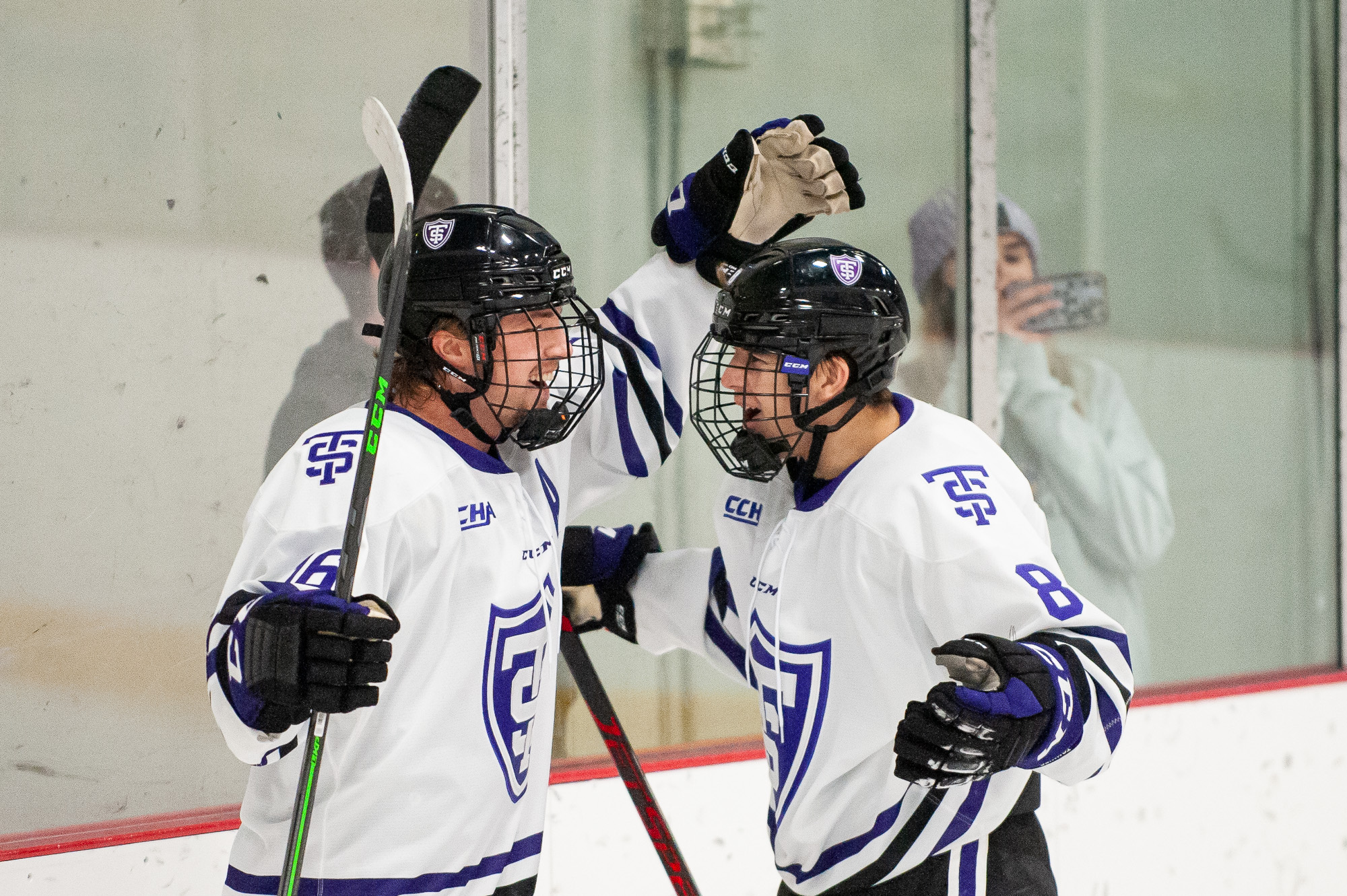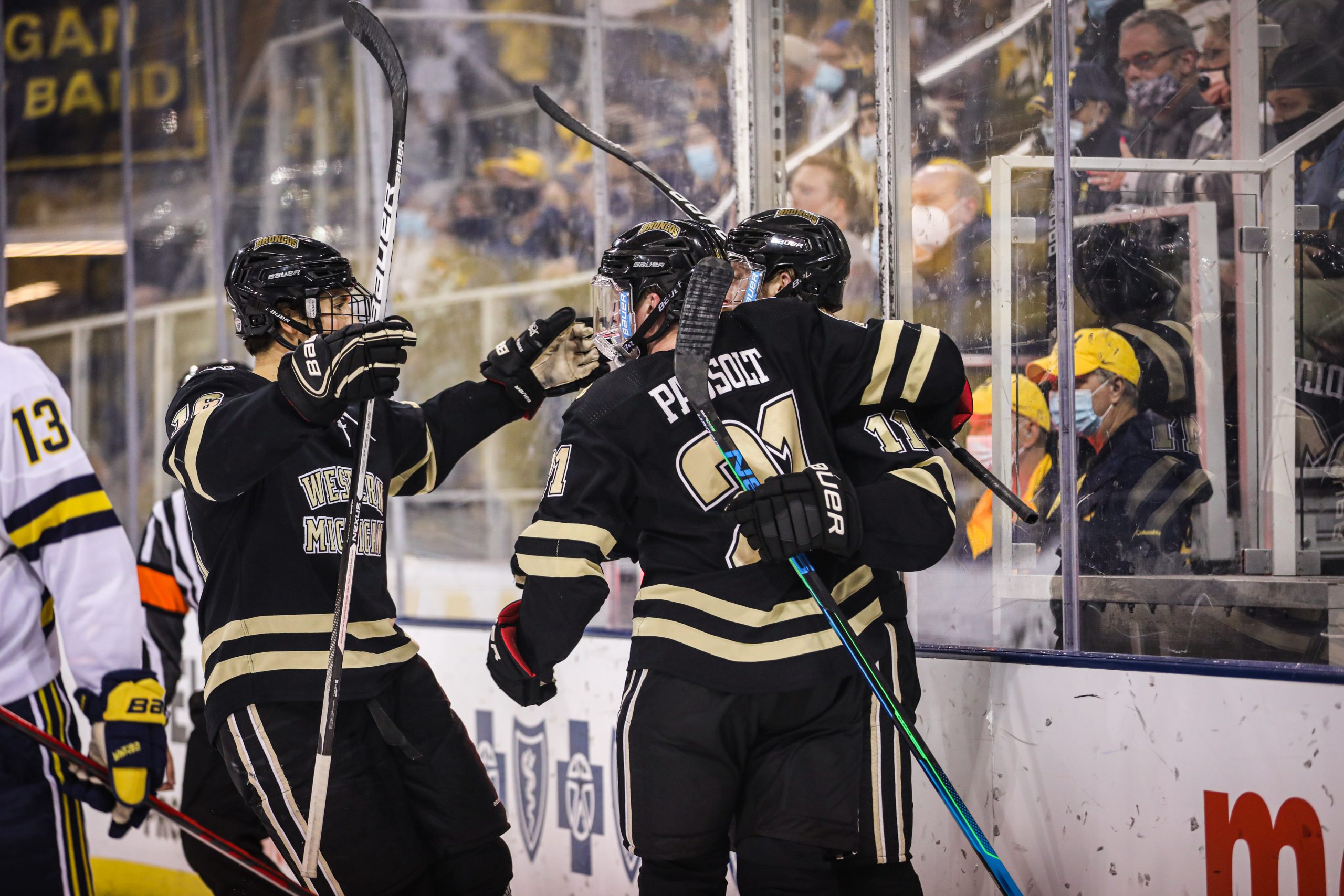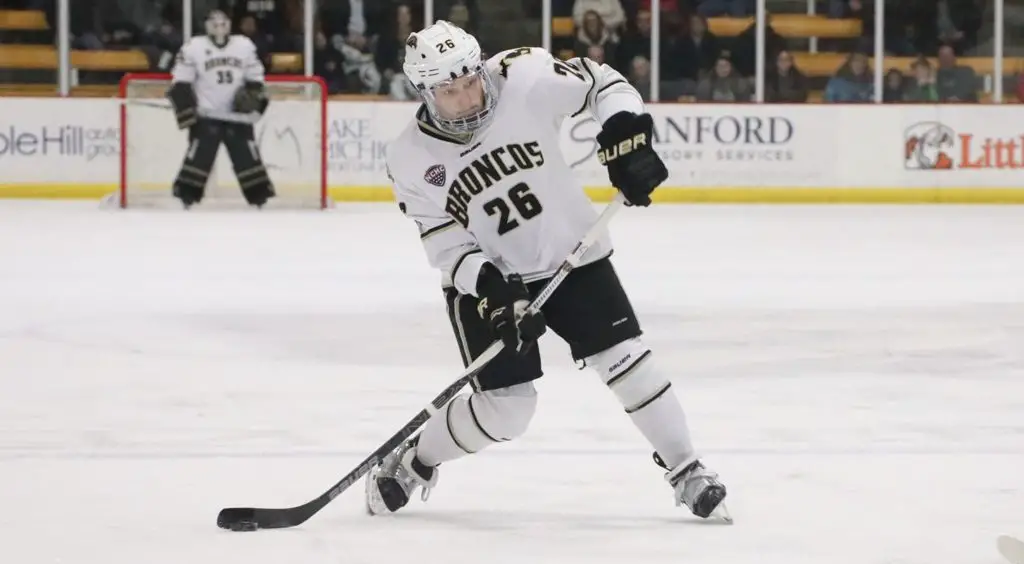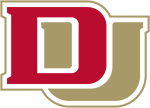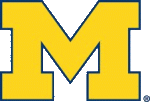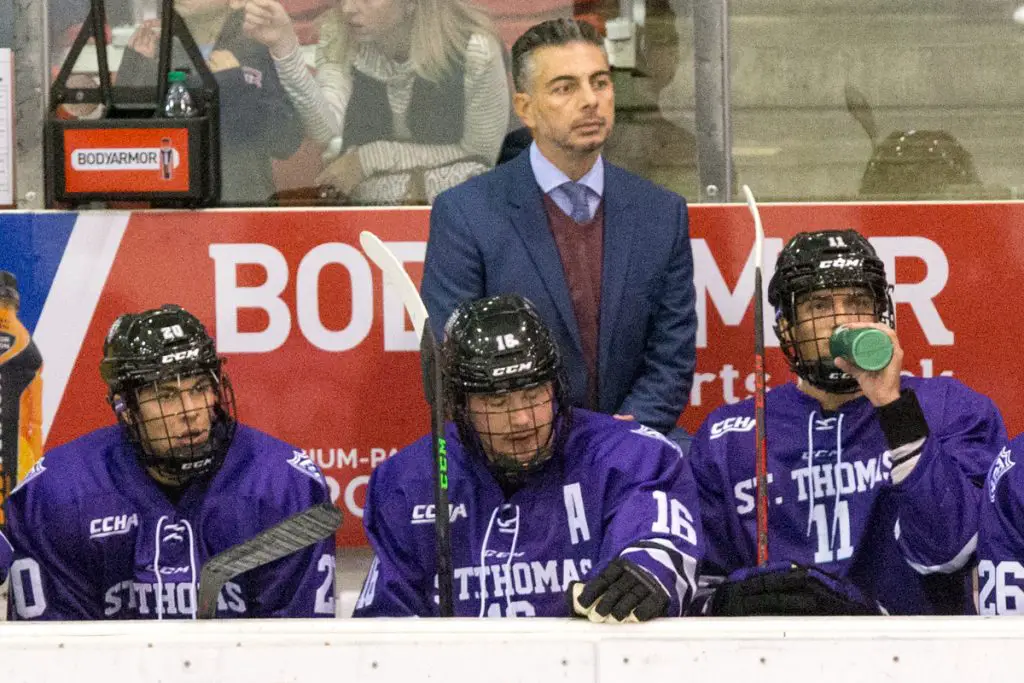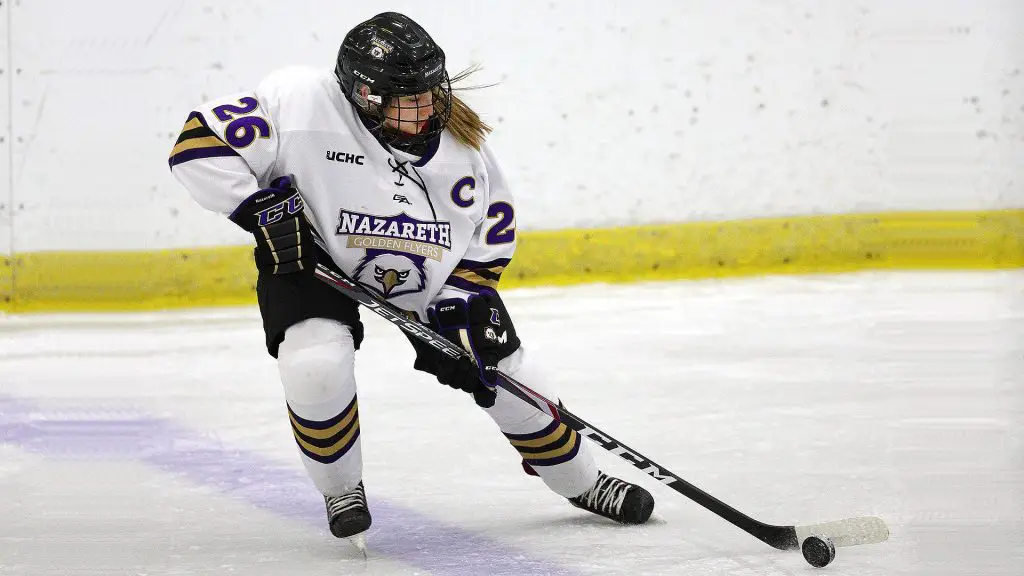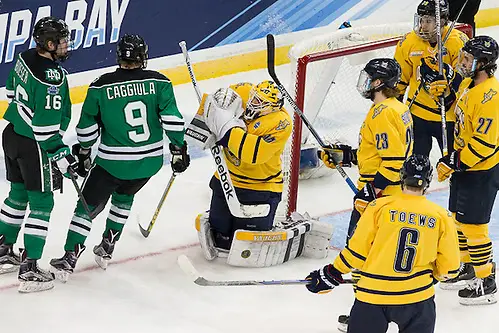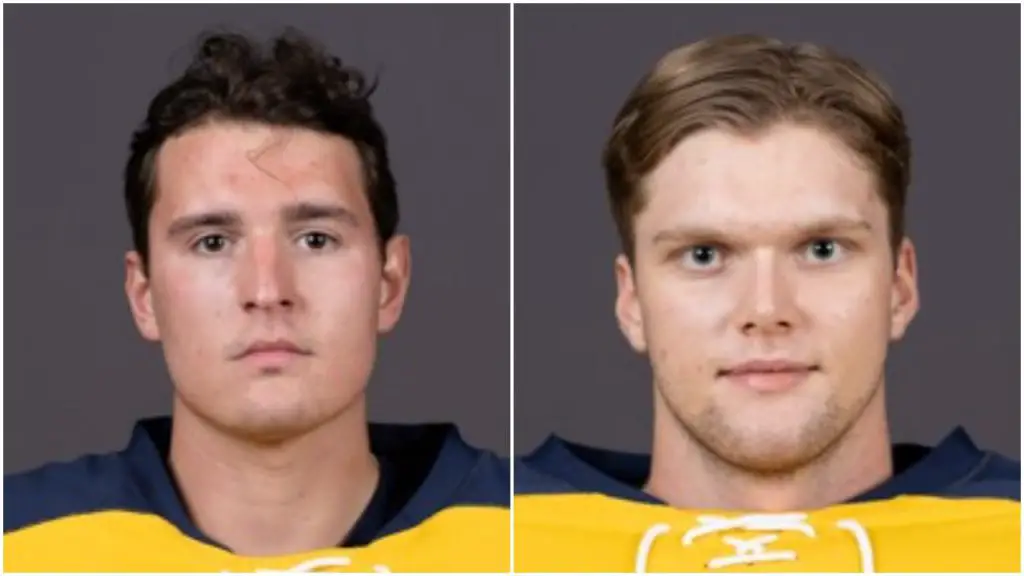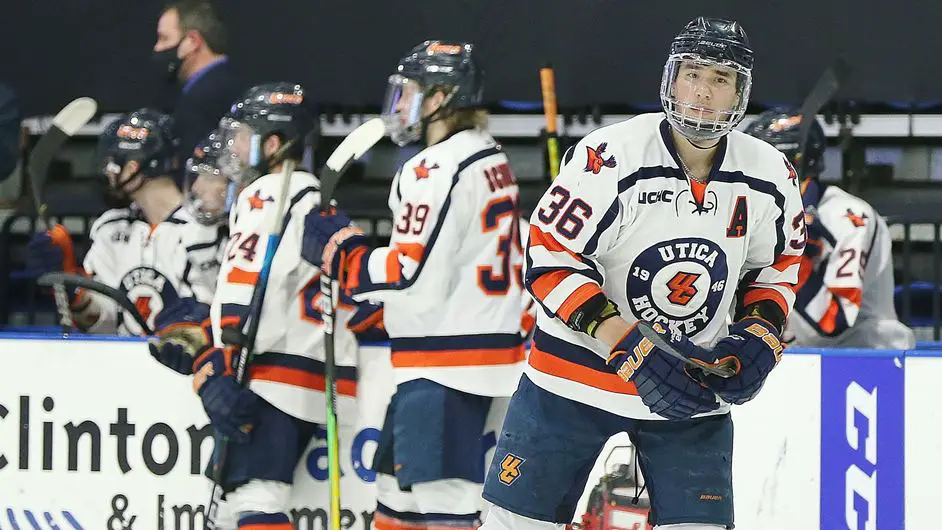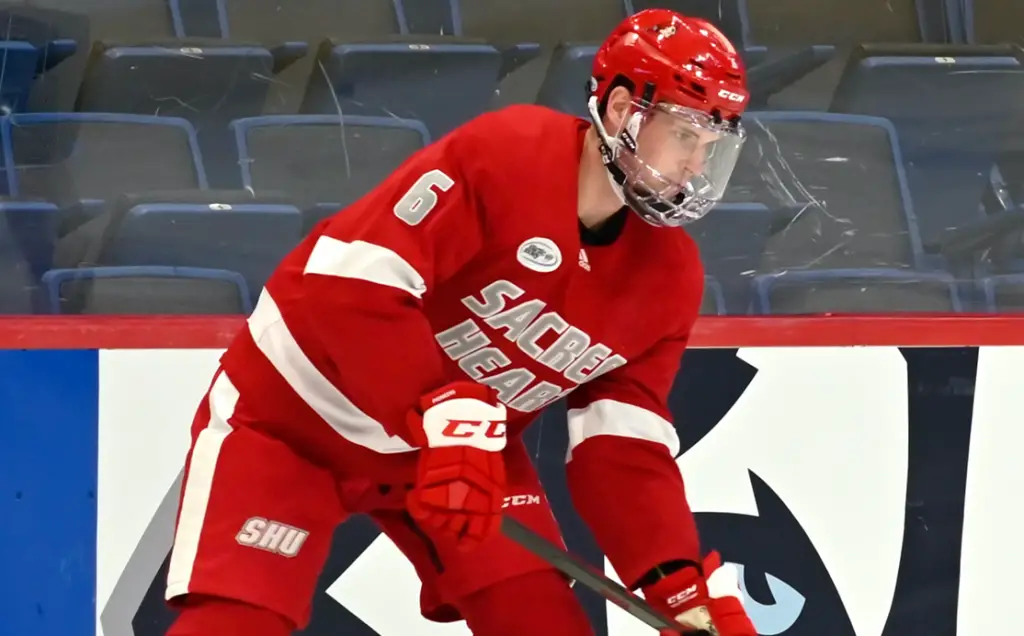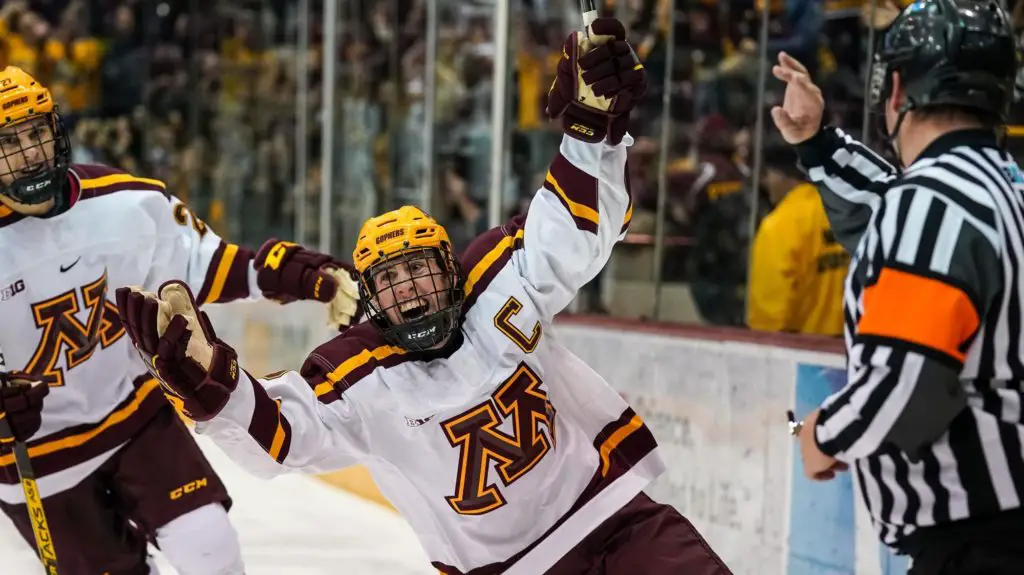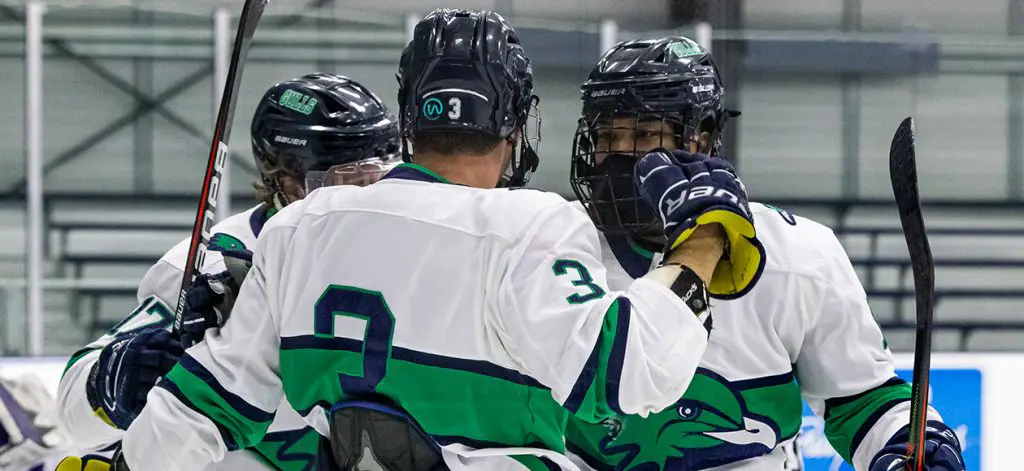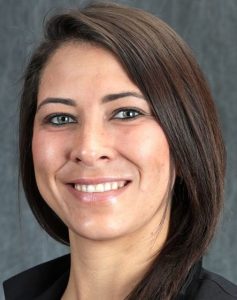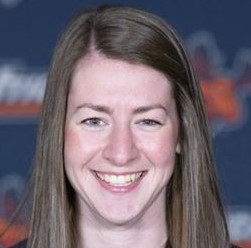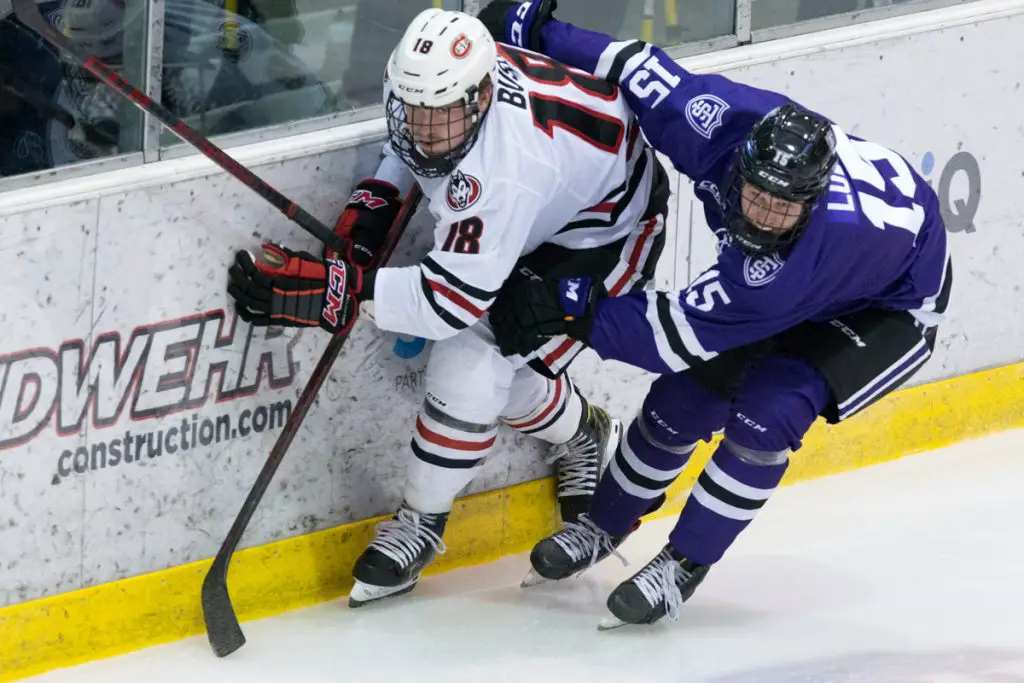Nicole: Welcome back for another women’s college hockey season! Arlan and I are back to volley questions back and forth and share some insight into what we’ve seen so far this season.
It’s been an interesting start, to say the least. I definitely felt more lost than normal when I was compiling season previews this year with all the roster changes, teams who hadn’t played in a long time and new players. But even knowing how much was truly up in the air, I’ve still been surprised by a number of teams and results in the first few weeks of the season.
I’ve already declared myself a part of Team Chaos this season. There have been upsets, near upsets and great performances and I love it. I have no idea what’s going to happen in any given game, but frankly that’s a lot of fun and I’m determined to enjoy the ride . There’s been so much good hockey already in games that on paper looked like they’d produce very different outcomes.
I’m kind of loving that I have no idea what is going to happen in each week’s games and that every time I check Twitter or the scoreboard page on USCHO, there’s a surprise. I watch a lot of streams, but I don’t tend to hop around. I usually try to stay with one game all the way through, but this year I’ve been more likely to check in on different outcomes and see how teams are playing as a game winds down.
I know you always remind me that individual upsets don’t really signal any major changes as we’re usually talking about the same teams as the end of the season, but I think all this uncertainty makes for an exciting season and helps draw in fans. Every week is feels like all the games are compelling and worth watching no matter who is playing and that feels like it can only be good for the game.
Arlan: There is some degree of the unknown at this point in every season, but now, I feel like it has been compounded by a number of factors.
Much of the loss of information stems from Covid-19 in one way or another. For the most part, fans weren’t allowed at games last year. All teams played abbreviated schedules. Some leagues and teams didn’t play at all. The Under-18 World Championships didn’t happen, so we missed out on data points of how top recruits from around the world compare to each other.
A person tries to watch as much as possible online, but the quality of streams varies widely. It isn’t obvious to me why Rensselaer and Minnesota State can put out a decent product, while the video quality from Ohio State is infamously bad. It’s not just women’s hockey that gets crumbs, as I have seen the volleyball video that Michigan State produces; Eadweard Muybridge’s 1878 shots of a running horse are likely better. I guess the Spartans could be dealing with the financial fallout of inflicting Larry Nassar on a few generations.
I’m finding it more difficult to learn what happened in a game that I didn’t watch now that collegehockeystats.net is no longer covering the sport. The alternatives that I’ve found don’t have as much information, and some of the information isn’t reliable, even for something as simple as a box score. One team may list a team’s entire roster, even when it approaches 30 players, while another doesn’t show all of the players who were dressed for a game. I’ll watch a player score into an empty net, and the next day, it is shown as an extra-attacker goal. As with any change, we’ll figure it out eventually, but it looks like it will take substantial effort just to reach the same level.
Another challenge in figuring teams out is that there is more flux this year. It’s an Olympic year, so we have the players lost to centralization or the midseason departures that we’ve come to expect. Due to the NCAA’s decision to not count last year as a season of eligibility, we have fifth-year players all around the country. That creates more movement, both from student athletes who have earned their degree but still have eligibility as they enroll in grad school somewhere else, and young players who expected to have a spot waiting with one program forced to look elsewhere if they wish to start their careers on schedule. You can also see a ripple effect as those transfers create logjams on other rosters.
What are your early reads into who might be some of the early winners and losers of all of this roster mayhem?
Nicole: I think the obvious choice for winner when it comes to additions is Ohio State. There’s not a part of their game that didn’t improve thanks to the talent they added to their team this offseason. They also strengthened their own standing by adding players from other WCHA squads. The biggest is Clair de George. It’s not just that she will have an impact for the Buckeyes, but that Bemidji State is now without their biggest offensive weapon. The Beavers are one of the losers in all this shuffling.
A team that I think has really benefited from the bonus year of eligibility is Colgate. Their roster is virtually unchanged from last year’s Frozen Four – they literally lost one goal. One of the Raiders’ strengths is how well they play as a team and work together. They have virtually no adjustments they have to make or work through. Being able to start the season like it’s already mid-year in terms of comfort level is a big advantage for them.
I might have said the same thing about Northeastern, but the opening few weeks haven’t been as smooth for them. I’m not sure that continuity was actually any help for the Huskies.
Wisconsin probably would have been just fine without bringing back their bonus year players, but obviously having Daryl Watts on your top line makes a difference. Folks will focus on her, but I also think having Grace Bowlby on defense and Kennedy Blair in goal are big for the Badgers. The returners also helped cover up the holes that might have been there with Natalie Buchbinder, Lacey Eden and Caroline Harvey centralizing with Team USA.
Incoming players for the next few years are going to take the biggest hit from this decision. Many players hadn’t officially announced commitments to teams, so we won’t know who had their plans changed because of teams having fewer open roster spots.
Anna Wilgren was a late add to the Team USA camp and I think Minnesota State will really miss her. They’ve already shown how much they continue to improve and she was a key part of their defense.
Did I miss anyone you see as having been impacted?
Arlan: Obviously, the biggest loser of all was Robert Morris, as the Colonials went from being an NCAA Tournament team to not having a team at all. That’s hard to top, and is a big part of the reason why the Buckeyes have so many additions via transfer.
But as much as Ohio State added to its roster, it also lost Emma Maltais to Canada’s centralization. I don’t know that they have a single skater on their current roster who can match her impact, although I’m often proven wrong.
There are other centralization hits. I’d say that the biggest of all figures to be the loss of Sarah Fillier from Princeton. The timing has been awful for the Tigers. They win their first ever ECAC Championship in 2020, and seemingly, nothing has gone right since. The pandemic wiped out the 2020 NCAA tourney, as well as Princeton’s season last year. Eden opts for Wisconsin having never played for the Tigers. By the time that Fillier returns next year, the roster will have turned over immensely from the one that she last skated with.
Minnesota lost Abbey Murphy and Patty Kazmaier Top-Three Finalist Grace Zumwinkle, but similar to the Badgers, I think that they’ll find other people to plug into their forward lines eventually. The loss of Zumwinkle was evident early, though, as the Gophers went scoreless on the power play through their first four games, and looked like they had no clue as to what to do without her one timer being an option. In any case, I expect that Minnesota will win or lose based on what happens at the other end of the ice.
St. Lawrence is another team that I think will have difficulty filling the centralization holes left by Anna Segedi and Julia Gosling. They were the only Saints who were in point-per-game territory last year.
The team that rivals OSU for the title of win-some-lose-some is Minnesota-Duluth. The Bulldogs lose WCHA Defensive Player of the Year Ashton Bell from their blue line, but add one of the most dangerous players in the country in Elizabeth Giguère. With Giguère, Gabby Hughes, and Anna Klein, UMD’s top line can rival that sent out by anyone. The question for the ‘Dogs will be what else can they bring to the table.
It will be interesting to see how Clarkson fares minus Giguère, as she’s an irreplaceable talent. The Golden Knights still have Caitrin Lonergan, who started her career at BC during the Obama Administration, but other than her and Gabrielle David, they don’t return proven scorers. The schedule makers have given them time to figure things out, as the teeth of Clarkson’s schedule doesn’t arrive until after the new year.
You said that Northeastern was largely intact, but Alina Mueller has only appeared in one box score, and has yet to play a big role. If she doesn’t bounce back from her injury at the World Championships, the Huskies have demonstrated that they just aren’t the same.
I’m not sure anyone has been as up and down from one game to the next on a weekend as UMD. The Bulldogs dominated the Mavericks to open the season, then lost the next day. They struggled to get much going in the first game against the Gophers, but scored five goals in winning the second game in overtime. The pattern was similar versus Wisconsin, but this time UMD came out on the short end of the three-on-three display.
Have you noticed any other team being as on and off as Maura Crowell’s crew?
Nicole: My first thought was Boston University. One of the two teams to take down Northeastern already, they followed that up with ties and shootout losses to New Hampshire (who they’d already beaten 4-2 and 5-0) and Merrimack.
I admit I didn’t have high expectations for the Terriers this year. I thought they’d end up in the middle of the Hockey East pack. Goalie Corinne Schroeder moved on, Jesse Compher graduated and I wasn’t sure who would step up for BU this year. So the win over NU was a surprise and big.
But now I have no idea what to expect from them or what the rest of their season will bring. I like that the Terriers are a team that aren’t leaning on individual players, but instead their strength comes from how well they all play together. I think they’ll continue to improve as the season goes on, but I hope that happens before too much damage is done to both their conference standings.
Though not quite the same as you mentioned, another team that feels like it’s on a roller coaster so far is Boston College. They’re 5-0, but only by the skin of their teeth. The Eagles have eked out one-goal wins in each of their games so far. I love that resiliency and pulling out the wins, but I also wonder why some of these games have been so close.
We’ve talked in years’ past about the unpredictability of BC and I feel like it’s a good sign for them to get these wins, so maybe I’m not being fair, but every week it feels like I’m holding my breath for them and I’m not sure that’s sustainable all season.
We’ve had four weeks of games already and the Ivies are about to join in. Which teams or players have stood out to you, for positive or negative reasons?
Arlan: We wondered what St. Thomas would look like in its first season of Division I. Sure, Joel Johnson’s new team had a rough weekend against Ohio State and former colleague Nadine Muzerall, but that’s often the case even for his former team. Beyond that, the Tommies’ results have been about as good as they could hope. They got their first WCHA win via a split with Bemidji State, and followed that up by taking four of six points in a home-and-home series with St. Cloud. That adds up to a surprising fourth place in the current WCHA standings. St. Thomas’ next three WCHA series are UMD, Ohio State, and Wisconsin, so it will need to take full advantage of the season’s first non-WCHA action versus RIT to retain some positive momentum.
While it can’t compete with a first win, it must have felt almost as good to the veteran players for Rensselaer when it swept Union on October 8 and 9. The Engineers last win before then came March 2, 2019 over Cornell, the last victory in a 14-win season. Since then, they’ve endured a winless 2019-20, and a season lost to Covid. Congratulations RPI!
While it hasn’t been facing championship contenders, Colgate has nonetheless won its first eight games by a composite score of 50-9. The 2016-17 Raiders were undefeated over their first 13 games, but they had to settle for a tie in game six. Colgate reached the championship game the following season after winning its first seven contests.
Connecticut and Ohio State are still perfect at 6-0.
One of the players who has been instrumental in the Buckeyes maintaining a perfect record is junior Jennifer Gardiner, who is tied for the team lead with 11 points, just shy of a two-points-per game pace. She was constantly able to use her speed to get around the corner when I watched her versus Minnesota, aiding Gardiner to her fast start. She wasn’t as prolific during her first two campaigns, when her average was more like half a point per game.
I did try to identify other breakout stars by scanning the points leaders, but those look to be dominated by players from Wisconsin and Colgate. I’ll need to see if they can keep producing when the quality of the opponent climbs a notch or two.
In terms of negatives, I’d prefer to wait more than a month before calling anyone out.
Something that is neither a team or a player that has stood out is the rule tweak such that the Ratings Percentage Index will consider an overtime win to be worth 55 percent of a regulation win, while an overtime loss is 45 percent. I haven’t seen if the PairWise rankings will similarly weight overtime results when looking at Common Opponents and Head-2-Head results.
What are your thoughts on this or any other rule change?
Nicole: One thing that sticks out to me in terms of these continued tweaks to things – the 55/45 split you mentioned above, some conferences taking out shootouts in event of a tie, the 1.5 points the ECAC is giving to teams that end in a tie after OT – don’t really address the root problem and just feel like they’re making things more complicated in a way that doesn’t solve anything or help anyone. It feels like we’re trying to game the system instead of just, you know, fixing the system.
Pairwise is a great system on the men’s side, but it relies heavily on comparing conferences to understand how good or bad each team is relative to one another across the country. With fewer teams and just a few weekends a year for non-conference games, the system doesn’t work very well on the women’s side. It’s a small sample size that cannot give us meaningful data.
And because the Pairwise is so reliant on non-conference games, there is a lot of jockeying by teams in terms of scheduling. Top teams tend not to schedule tougher non-conference opponents so they don’t get dinged by possible losses come the end of the year. And teams that might otherwise be on the outside looking in take the risk of scheduling tough opponents in hopes they’ll get a ratings boost out of it.
I both understand why conferences and teams want to get some “credit” for taking a game to OT, but also think that ultimately, it’s about jockeying for position and being conscious of what zero points or zero credit for that game means to a team in the rankings.
It’s a case of knowing that the NCAA is going to use this flawed system where the way things are weighted in RPI seems arbitrary and Pairwise was created for a different set of circumstances and women’s hockey gets shoehorned into it and instead of fighting for a framework that is actually useful, working to be successful in those parameters.
Pairwise was a problem before last season when no one played outside their conference due to Covid, but that really put a fine point on the flaw of the system.
So basically I’m frustrated by each small change every year because they aren’t solving the actual problem. And I don’t feel like the NCAA is going to acknowledge or do anything to change the process or stop trying to shoehorn the women into a framework not set up for the sport as it exists right now.
In other offseason committee news, they decided to table a discussion about expanding the number of teams that make the NCAA tournament. There has been a push to make it 10 or 12 teams that has particularly been spurred on by the fact that NEWHA will receive an autobid soon. The Covid year has messed up some of the timeline on these things, but I believe NEWHA is scheduled to receive their autobid in the 2022-23 season. That would make five auto bid spots and just three at large bids as the tournament format stands right now.
To further complicate this conversation, with Robert Morris cutting their programs, the CHA is now below the necessary six team threshold for receiving an autobid. They get a two-year grace period to get back up to six before the autobid is taken away.
All hopes are that RMU’s programs come back (though I have to wonder what players would trust them enough to commit there), but in the meantime we have to assume they’re not. I’d assume the CHA is going to do what they can to bring in another team. What are your thoughts about what team could or should join them?
I don’t think we’ve ever really talked about expanding the tournament. You have even more historical perspective than I do. Do you have strong feelings about it?
Arlan: I feel that tournament expansion is pointless while we have tournament quarterfinals where the primary directive is to reduce flights. The first round of NCAAs will just be more rehashing of conference tournaments.
Having a larger field is a positive if those teams are capable of doing something once they get into the field. What would the expectation be for the ninth team and beyond? Not much. It is like trying to pick the top 10 for the weekly rankings. At a certain point, one votes for teams because there has to be 10 of them, not because those last couple of teams have really made a deserving case.
The expansion from four teams to eight took effect in 2005. The first year, St. Lawrence went on the road and knocked off second-seeded UMD. In the third year in 2007, three quarterfinal hosts were upset. Clearly, the time was right for expansion. The additional teams were able to impact the event, not just put their names into a bracket so that they could say they were there. I’ll be in favor of expanding the NCAA Tournament once we have more teams whose inclusion will improve the event.
I think Division-I needs more contenders. For years, WCHA teams dominated, and someone like Dartmouth, St. Lawrence, New Hampshire, or BC would rise and fall without ever quite reaching the pinnacle. Both Cornell and Princeton looked poised to make some noise in the 2020 tournament that was wiped out. What toll did the year off take on their programs? Penn State took advantage of the unique schedule to have a breakthrough year; how close are the Nittany Lions to being able to contend? The first couple of series this year suggest we’ll need to wait a bit more, or do you think that PSU is in fact very close to advancing to Frozen Fours and beyond?
Nicole: No, based on what we’ve seen to start this season, I don’t think Penn State is poised to take another step forward just yet, though I’m fully prepared and hopeful they’ll prove me wrong.
And history has shown us that even the best CHA teams have not fared well once they make it into the tournament.
Your argument about more pointless or blowout games is probably the best one I’ve heard in opposition to expansion. Much like what I said about Pairwise above, there needs to be systemic change from the NCAA to make this viable. I can and have ranted extensively about how unfair the unequal treatment of the women’s hockey tournament is, but maybe it’s time to do so again, since publicly shaming the NCAA during the women’s basketball tournament actually got results.
Most conversations about expansion focus on how there will only be three at-large bids, but I’ve not heard a lot of talk about the logistics or details or how adding more teams would further stretch what is clearly a very meager budget allotted for this sport.
One possible solution is doing away with quarterfinal host schools and bringing everyone to one site. I totally get why schools want to host those games, but it was incredibly convenient to have everyone in one spot for a week to play the tournament out in March. I know a lot of people would need to be convinced, since almost no one got to experience it in Erie, but I think making the tournament a six-day big deal could be a positive and would help eliminate the distance part of the quarterfinal matchup equation, though again, that’s not fixing the actual problem, it’s working around it.
Even in 2020, the NCAA had a revenue of around half a million dollars. They lost about 50% due to the pandemic, but since they regularly pull in over a billion dollars, that’s still pretty good for a non-profit, tax-exempt entity.
I know a good number of coaches and athletic directors are in favor of expanding the tournament, so it feels like an inevitability, but I do hope we see some systemic change from the NCAA alongside it.
Switching gears, let’s talk about this week’s big series. We talked about them both individually above, but should we talk about the big series between #1 Wisconsin and #2 Ohio State? It feels like the outcome is bound to be a split, but how do you think these teams match up down their lines? Do you see anything that stands out that might be a decider here?
Arlan: When these two play during the regular season in recent years, the decider is that one team scores a goal and the other team doesn’t. I can’t find any science beyond that. They almost reprise the days of Big Ten smash-mouth football: try not to do anything offensively that will cause you to lose the game, and hope that your defense can cause a turnover that leads to a score. For a couple of coaches who were elite offensive performers in their playing days, they sure can embody that “defense wins championships” mentality, at least against each other.
Based on a very small sample size and my own uninformed biases, I think that a higher-scoring game would favor Wisconsin. If you match the career numbers of Wisconsin forwards against those from Ohio State, it paints an optimistic picture for the Badgers. I’d give the Buckeyes a slight edge on the blue line and in net. I’d say that I like OSU’s chances better in a 2-1 game than in one that finishes 5-4.
However this weekend shakes out, I doubt it matters much in the big picture. Both teams will make the NCAA Tournament. Defeating Wisconsin in October doesn’t indicate the same success come March. Muzerall has impressed me the last couple of seasons with how quickly she has her squad up to speed. Johnson has traditionally taken advantage of all the months available to him to wind his club up like a big diesel engine.
Looking beyond this weekend at the season as a whole, if you told me I had to either bet on the Badgers to win it all or I could bet the rest of the field, the smart money would have to be on the Badgers. They have the proven track record. Other than a handful of players who were part of Clarkson’s 2018 run and Badger transfers, nobody else has the championship experience. Plus, I think that they could suffer a key injury or two and still get the job done.
Do you think differently, either about the importance of this weekend or Wisconsin’s odds of winning it all?
Nicole: The importance of the weekend probably comes in the intangibles. If one team performs significantly better, they’re going to become everyone’s odds-on favorite and have all the confidence in the world. It puts them in the drivers seat for the conference and the top seed at this point.
Ohio State has more scoring depth this year than they have had in years’ past, which I do think improves the way they match up against the Badgers, but the problem comes with trying to slow down the second and third lines. Both teams are softer on defense, so as you said, I think the game will hinge quite a lot on how the blueliners play. HIstorically, Andrea Braendli has had her best games in net against Wisconsin.
When Wisconsin stumbled in the first period of the second game against UMD last weekend, it was because they could not hold on to the puck. They managed one shot in that frame. They struggled to get into, much less hold the zone and just weren’t clean or crisp on passes or moving with the puck. They were able to self-correct for the rest of the game, but it definitely was a peek into what would work to knock them off their game and make them vulnerable.
You make a good point about regular season vs. post season wins. The Buckeyes have been much more successful against the Badgers in the first than the second. I like that OSU has the experience of last year’s tournament, but the roster is much changed from that group.
At this point, these two teams are the ones I’d pick to win it all. There’s still a lot of time to see more from other squads and to see if either of these two have faults that haven’t been exposed yet, but their depth is just hard to compete with and they’ve handled their games so far.
Of course, Minnesota and Colgate have a #3 vs. #4 matchup this series and if Colgate shines, I’d have to move them up into the conversation.
